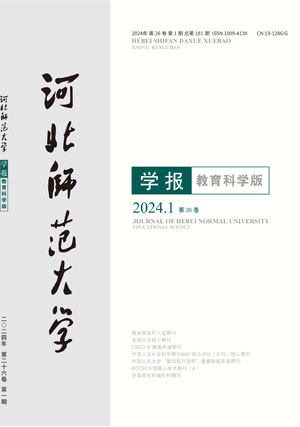期刊信息

- 刊名: 河北师范大学学报(教育科学版)Journal of Hebei Normal University (Educational Science Edition)
- 主办: 河北师范大学
- ISSN: 1009-413X
- CN: 13-1286/G
- 教育部名栏入选期刊
- 全国中文核心期刊
- CSSCI扩展版来源期刊
- AMI综合评价(A刊)核心期刊
- RCCSE中国核心学术期刊
- 全国高校特色栏目社科学报
- 中国人民大学“复印报刊资料”重要转载来源期刊
- 全国高校权威社科期刊
技术增强STEM教育的未来应用图景 ——基于《创新聚焦:技术有力支持STEM学习的九种方式》解读与启示
-
作者单位:(1. School of Education, Minzu University of China, Beijing 100081, China; 2. School of Education, Tianjin University, Tianjin 300350, China) -
起止页码:114 - 122页 -
DOI:10.13763/j.cnki.jhebnu.ese.2022.05.015
Technology Enhances Future Application Prospects of STEM Education: Interpretation and Inspiration of Innovation Spotlight: Nine Dimensions for Supporting Powerful STEM Learning with Technology by
摘要/Abstract
技术之于STEM内部是作为学科的存在,之于外部是STEM实践应用的助推力。在技术时代背景下,技术成为支持STEM教育的有力工具,具有双重性、可行性及有效性。解读美国《创新聚焦:技术有力支持STEM学习的九种方式》报告,从多方交互以构建协同网络、丰富化证据以获取真实体验、程序化设计以提升综合思维、实践型项目以解决实际问题四个层面深度剖析,对技术应用于T-STEM教育中的着力点与共性之处提出了具体建议:打造T-STEM教育共同体,充分发挥技术的工具助力;强调教学决策的重要性,真正发挥技术应用于STEM教学的意义;开发适应特定教学情境的技术工具,拓宽技术使用深度;保证师生及生生的有效交互,避免技术带来阻隔。
Technology exists as a discipline inside STEM and as a driving force for the application and practice of STEM externally. In a time of staggering technological changes, technology has become a powerful tool to support STEM education, for which it is feasible and effective with its dual properties of tradition and modernity. Innovation Spotlight: Nine Dimensions for Supporting Powerful STEM Learning with Technology is the report of a survey of STEM education by the US Department of Education. This paper makes an in-depth analysis of the report from four aspects, namely, constructing collaborative networks through multi-party interaction, inquiry through manifold evidence to gain authentic experience, design processes to enhance comprehensive thinking skills, and project-based learning activities to solve practical problems. Suggestions for leveraging technology to improve T-STEM learning include: building a T-STEM education community and giving full play to the instrumental function of technology; emphasizing the importance of teaching decision-making so that technology really works in STEM teaching; developing technical tools for specific teaching situations and deepening the use of technology; ensuring effective interaction between teacher and students and among students to overcome barriers caused by technology.
关键词
参考文献 29
- [ 1 ] Office of Educational Technology, US Department of Education. Inovation Spotlights: Nine Dimensions for Supporting Powerful STEM Learning with Technology [DB/OL] .(2019-10-07) [2021-12-23] .https://tech.ed.gov/files/2019/10/stem-innovation-spotlights-research-synthesis.pdf.
- [ 2 ] Wu Y T, Anderson O R.Technology-enhanced stem (science, technology, engineering, and mathematics) education [J] .Journal of Computers in Education,2015,2(3):245-249.
- [ 3 ] Kennedy T J, Odell M R L.Engaging Students In STEM Education [J] .Science Education International,2014,25(3):246-258.
- [ 4 ] Herschbach D. Technology education:Foundations and perspectives [M] .UK:Routledge,2005.
- [ 5 ] Mitcham C. Thinking Through Technology:The Path Between Engineering and Philosophy [J] . Technology & Culture,1994,36(4):125-128.
- [ 6 ] Kelley T R, Knowles J G. A conceptual framework for integrated STEM education [J] .International Journal of STEM Education,2015,3(1):11.
- [ 7 ] Bers M U, Seddighin S, Sullivan A. Ready for Robotics: Bringing Together the T and E of STEM in Early Childhood Teacher Education [J] .Journal of Technology & Teacher Education,2013,21(3):355-377.
- [ 8 ] Thomas B , Watters J J.Perspectives on Australian, Indian and Malaysian approaches to STEM education [J] .International Journal of Educational Development,2015,45(1):42-53.
- [ 9 ] Tytler R, Symington D, Smith C. A Curriculum Innovation Framework for Science, Technology and Mathematics Education [J] .Research in Science Education,2011,41(1):19-38.
- [ 10 ] Decoito I, Steele A, Goodnough K. Introduction to the Special Issue on Science, Technology, Engineering, and Mathematics (STEM) Education [J] .Canadian Journal of Science,Mathematics and Technology Education,2016,16(2):109-113.
- [ 11 ] Mejias S,Thompson N,Sedas R M, et al. The trouble with STEAM and why we use it anyway [J] . Science Education,2021,105(2):209-231.
- [ 12 ] 孙立会,王晓倩.智能时代下信息技术与课程整合的解蔽与重塑——课程论视角 [J] .河北师范大学学报(教育科学版),2020,22(4):118-124.
- [ 13 ] McGarr O, Lynch R. Monopolising the STEM agenda in second-level schools: Exploring power relations and subject subcultures [J] .International Journal of Technology and Design Education,2017,27(1):51-62.
- [ 14 ] Wesker M.. The World is Flat: A Brief History of the Twenty-First Century [J] .Journal of Global Information Technology Management, 2006,21(2):85-86.
- [ 15 ] Zouda M. Issues of power and control in STEM education:a reading through the postmodern condition [J] .Cultural Studies of Science Education,2018,13(4):1109-1128.
- [ 16 ] Nadelson L, Seifert A, Moll A, et al.i-STEM summer institute:an integrated approach to teacher professional development in STEM [J] .Journal of STEM Education,2012,13(2):69-83.
- [ 17 ] National Research Council (NRC). Improving undergraduate instruction in science,technology, engineering, and mathematics [M] .Washington, DC: National Academy Press,2003.
- [ 18 ] Wing JM.Computational Thinking:What and Why? [DB/OL] .(2010-11-17) [2021-12-23] .http://www.cs.cmu.edu/~CompThink/resources/TheLinkWing.pdf.
- [ 19 ] 孙立会,王晓倩.计算思维培养阶段划分与教授策略探讨——基于皮亚杰认知发展阶段论 [J] .中国电化教育,2020(3):32-41.
- [ 20 ] Graesser A C, Fiore S M, Greiff S,et al.Advancing the science of collaborative problem solving [J] .Psychological Science in the Public Interest,2018,19(2):59-92.
- [ 21 ] Kertil M, Cem G. Mathematical Modeling: A Bridge to STEM Education [J] .International Journal of Education in Mathematics Science & Technology,2016,4(1):44-55.
- [ 22 ] 孙立会,周丹华.儿童编程教育溯源与未来路向——人工智能教育先驱派珀特的“齿轮”与“小精灵” [J] .现代教育技术,2019(10):12-19.
- [ 23 ] Andrea D A . Changing minds : computers, learning, and literacy [M] .MIT Press, 2000.
- [ 24 ] 杨开城,窦玲玉,李波,公平.STEM教育的困境及出路 [J] .现代远程教育研究,2020(2):20-28.
- [ 25 ] Carlos L, Deborah, R-H, Elizabeth, T. et al.Meaning Making With Motion Is Messy: Developing a STEM Learning Community [J] .Canadian Journal of Science, Mathematics and Technology Education, 2016,16(2):169-182.
- [ 26 ] Don K, Ashley S.. Reconceptualizing STE(A)M(S) Education for Teacher Education [J] .Canadian Journal of Science, Mathematics and Technology Education,2016,16(2):183-200.
- [ 27 ] Alan G, Bryan Al. True STEM Education [J] .Technology & Engineering Teacher,2013,73(4):8-16.
- [ 28 ] Daisy W R.Simulations for stem learning: systematic review and meta-analysis [DB/OL] .(2014-03-01) [2022-01-23] . https://cdn.zspace.com/collateral/case-studies/simulations-for-stem-learning-exec-summ.pdf.
- [ 29 ] Hill C T. STEM Is Not Enough:Education for Success in the Post-Scientific Society [J] .Journal of Science Education & Technology,2018,28(1):69-73.
